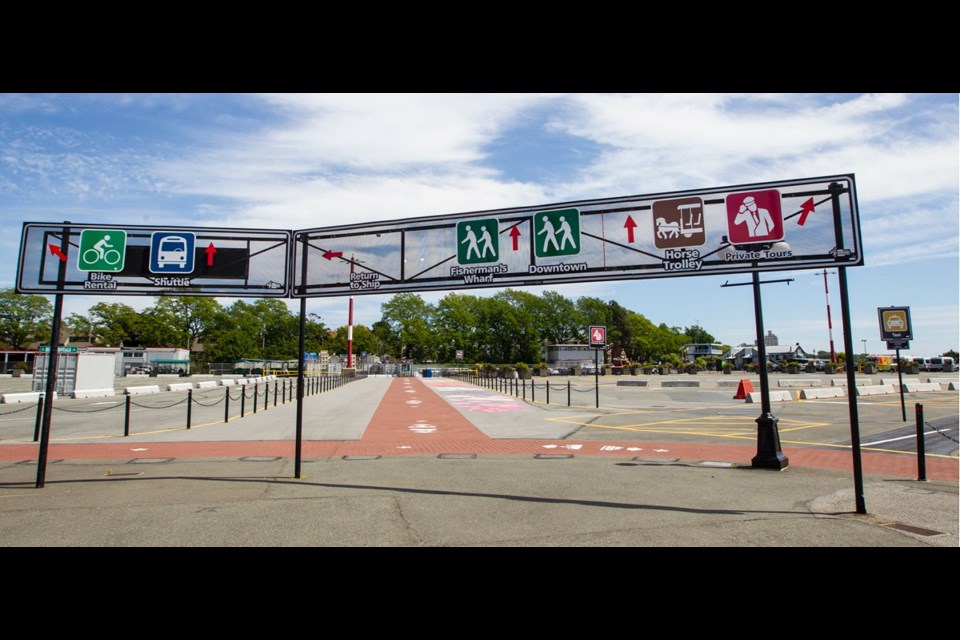The cruise-ship season that was forecast to bring more than three quarters of a million passengers to Victoria’s shores — and an estimated $130 million in economic activity — has been scuttled.
Everyone from street vendors to restaurants, retailers, transportation companies and suppliers is expected to feel the financial blow.
Federal Transport Minister Marc Garneau on Friday extended the ban on large cruise-ship visits to Canada to Oct. 31, citing concerns about the spread of COVID-19.
Victoria had been expecting a record 300 cruise-ship calls and 770,000 cruise-ship passengers from April through to the end of October.
“Although we expected this and prepared for it, financially it’s a significant blow for the region,” said Ian Robertson, chief executive for the Greater Victoria Harbour Authority, which operates the Odgen Point cruise terminal. “But we have always said the health and safety of Victoria is our No. 1 priority.”
Robertson said he has had several discussions with Garneau since mid-March, and has urged the federal and provincial governments to provide financial supports for businesses affected by the cruise cancellation.
“I’m calling on them to come up with ways to help the tourism industry through this period, at least until there is a rebound next year. Some businesses will not survive.”
John Wilson, president of Wilson’s Group, which provides the majority of transportation for the local cruise industry, said it’s another severe body blow for his company, which has already lost 97 per cent of its revenue to the COVID crisis. He said losses for Wilson’s Group could range from $5 million to $10 million this year, depending on the severity of the downturn.
Almost all of Wilson’s businesses, including the Grey Line sightseeing buses and CVS division that transport cruise passengers downtown and to Butchart Gardens, are not operating.
Wilson said financial help from the federal and provincial governments is desperately needed — either in grants or industry loans — to get tourism-related businesses, including his own, through to the 2021 season, “or many just won’t survive.”
“Going 18 months or longer without any revenue … it’s just not feasible,” said Wilson.
Garneau said he understands the cruise ban will have a massive impact on the tourism industry. He said the federal government is studying ways to offset the loss, but provided no details.
A 2016 study found the industry contributed about $3 billion to Canada’s economy, including $1.4 billion in direct spending by passengers, and about 23,000 Canadians were directly or indirectly employed because of the ships.
Cruise ships were one of the first- and worst-hit sectors in the COVID-19 outbreak, as hundreds of passengers fell ill on ships sailing in various parts of the world. Transport Canada monitored hundreds of ships with Canadians on board as they battled outbreaks or were not allowed to dock in planned ports, as countries closed to foreign tourists to keep COVID-19 out.
One Canadian passenger on board the Grand Princess died in Japan after being hospitalized with COVID-19.
In a Times Colonist editorial this week, Chamber of Commerce CEO Catherine Holt and Paul Nursey, CEO of Destination Victoria, painted a grim picture of the local tourism industry. The region has a “disproportionally high” number of tourism businesses, with two in five working people employed either directly in the sector or in businesses dependent upon tourist spending.
“National and international travel are lifelines for these businesses. With borders and our waters closed to critical sources of travellers, airlines reducing flights and government directing people to stay local, tourism businesses are staring at a total collapse of their sector,” they said.
Holt and Nursey said the notion that tourism in the capital region can survive on local and regional travel is not supported by data.
Travellers from B.C. contribute less than one third of Greater Victoria’s annual tourism revenue. “We typically have 2.4 million visits by B.C. residents annually and that would need to grow to six million visits to offset lost revenue — completely unrealistic,” Holt and Nursey said.
Without significant financial support, and encouragement of local, provincial and national travel, “the majority of our businesses won’t survive 2020, let alone until spring 2021, when prospects for travel hopefully improve.”
Jeff Bray, executive director of the Downtown Victoria Business association, said cruise passengers often make the difference between being in the red or the black for some businesses in any given year.
He said it’s more important than ever for locals to support local businesses.
Speaking from the corner of Douglas and Yates streets after lunch at a sushi restaurant, Bray said he’s seeing plenty of foot traffic and it was encouraging that many people were carrying shopping bags.
“Businesses are being faced with the border being closed and travel between provinces restricted, so it’s critical for Island people to shop local and take in attractions,” he said.
“It’s up to all of us to be the difference.”
Robertson said the cruise business represents about 70 per cent of the harbour authority’s annual revenue, which supports operations across all of its properties, including the breakwater, Inner Harbour Lower Causeway, Ship Point and Fisherman’s Wharf.
He said without cruise income, the harbour authority is sidelining capital projects, closing some facilities and reducing maintenance and repairs without compromising safety.
“The breakwater is an example,” he said. “If one of the railings broke loose, we wouldn’t have the resources of people to fix that railing.”
The harbour authority has already cut its workforce by 50 per cent and reduced its expenses by half.



